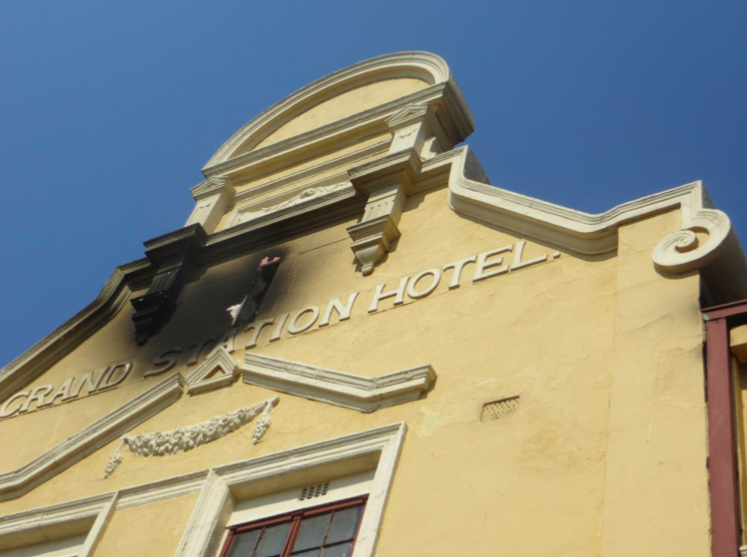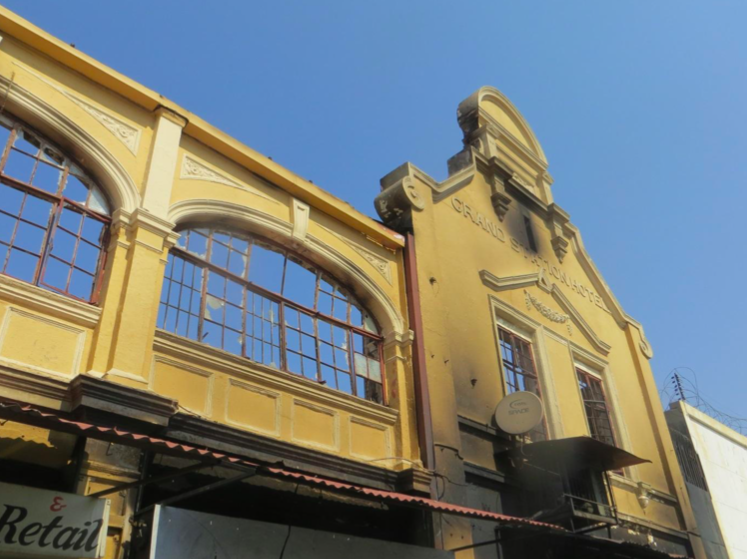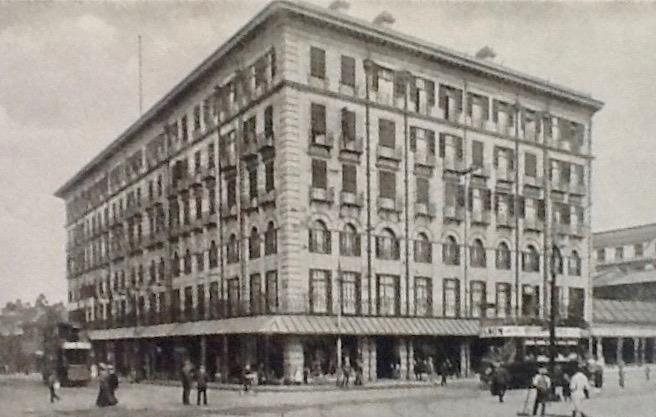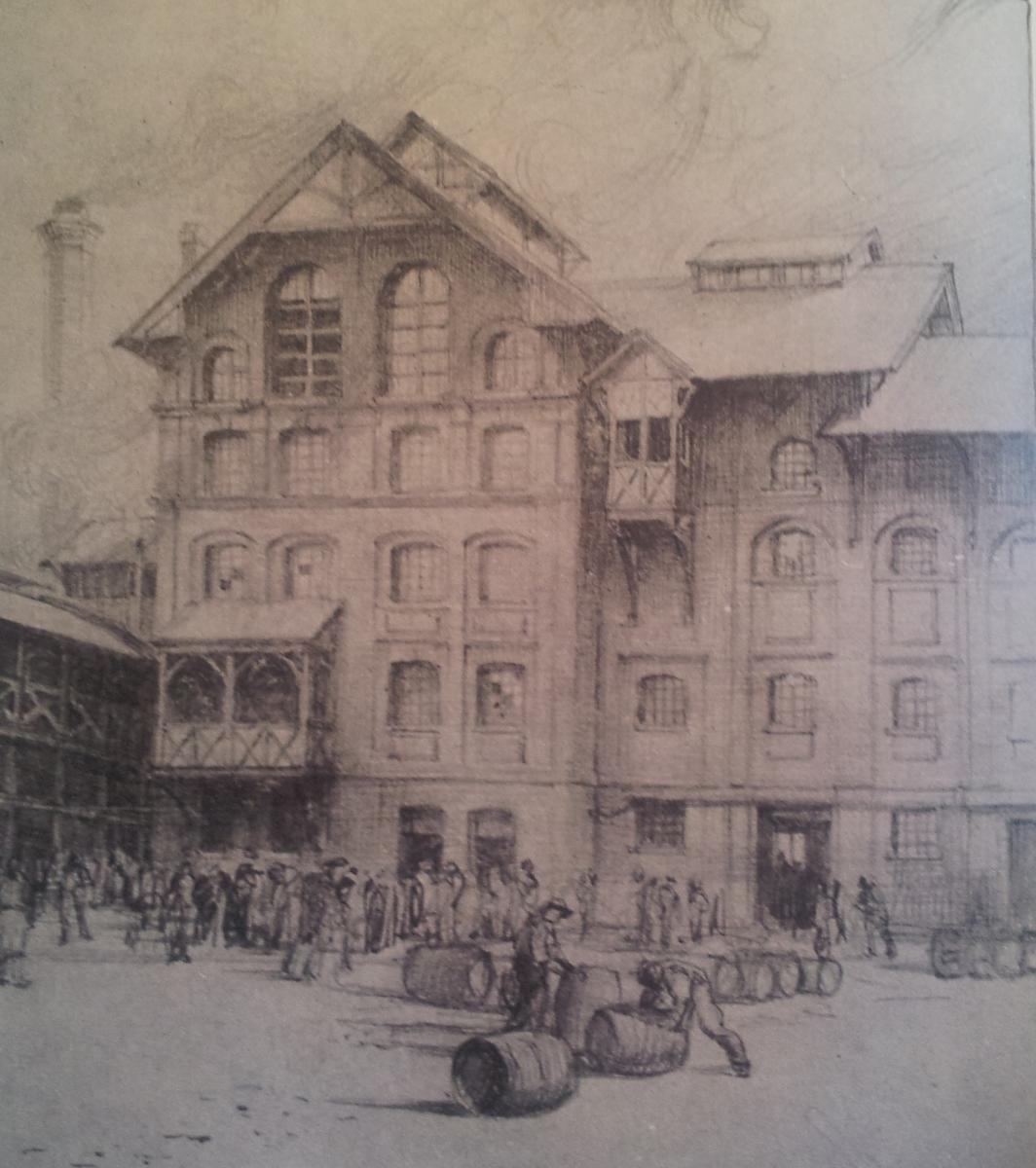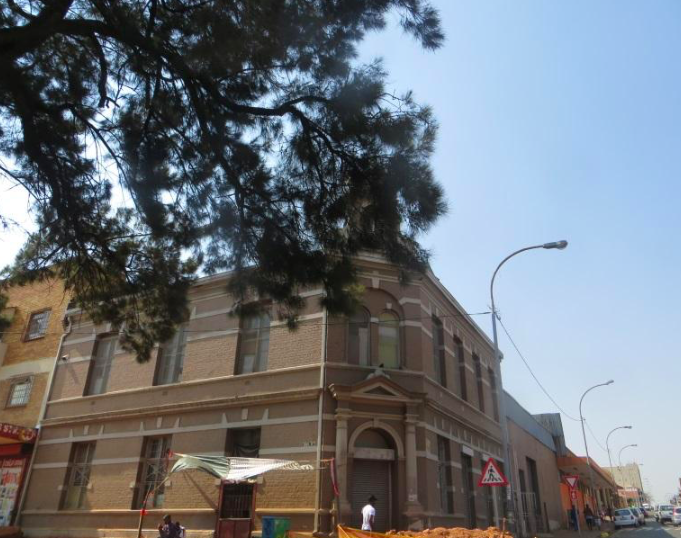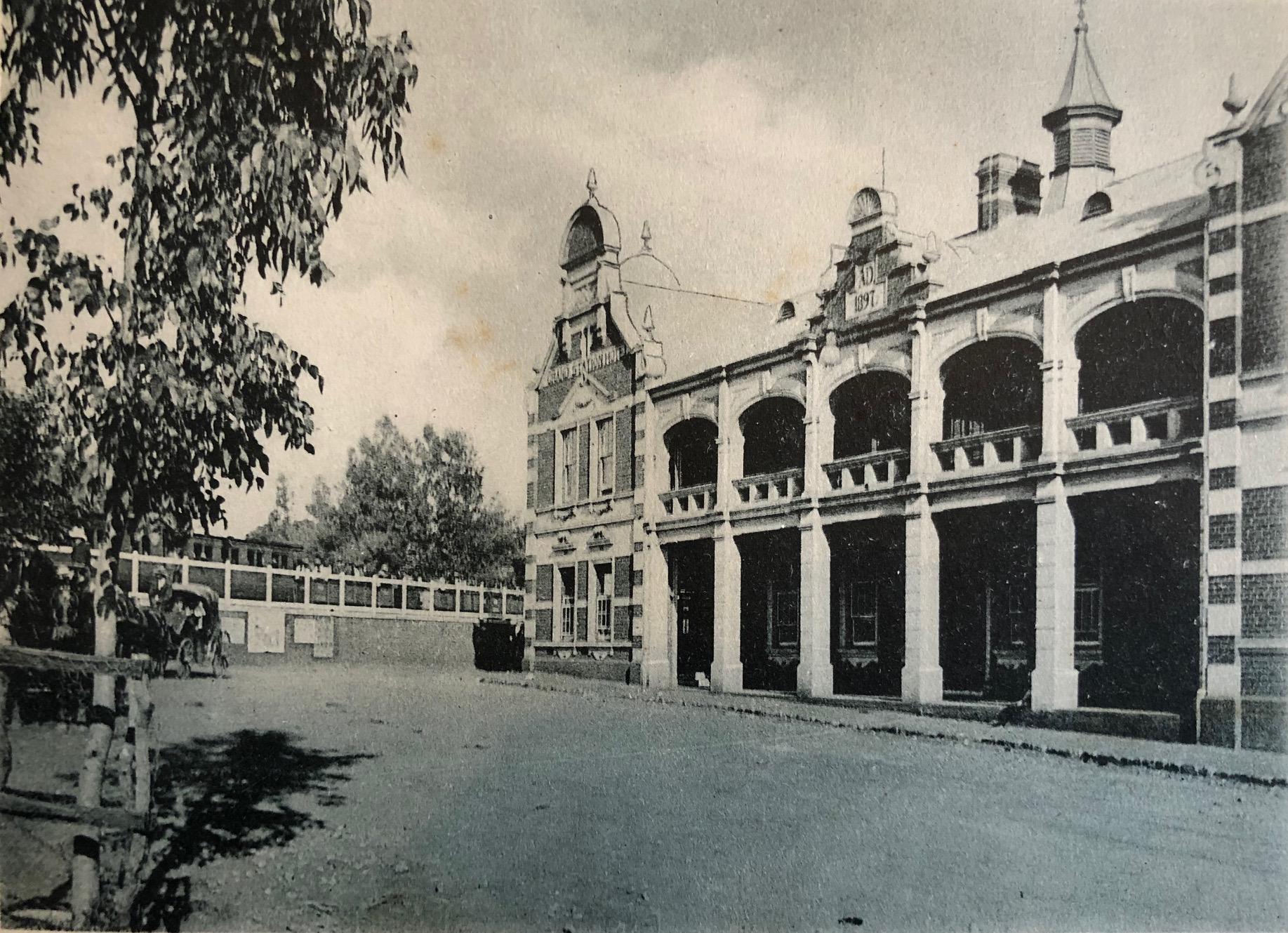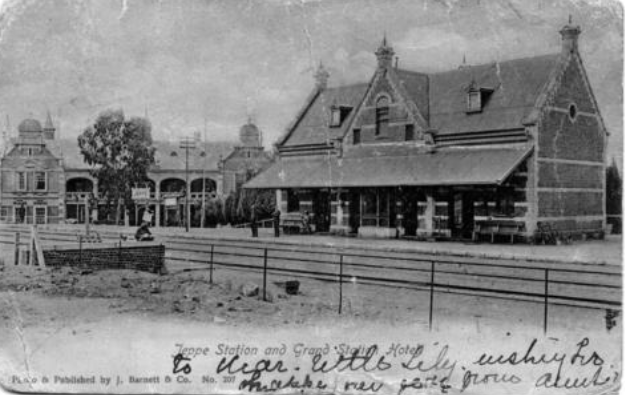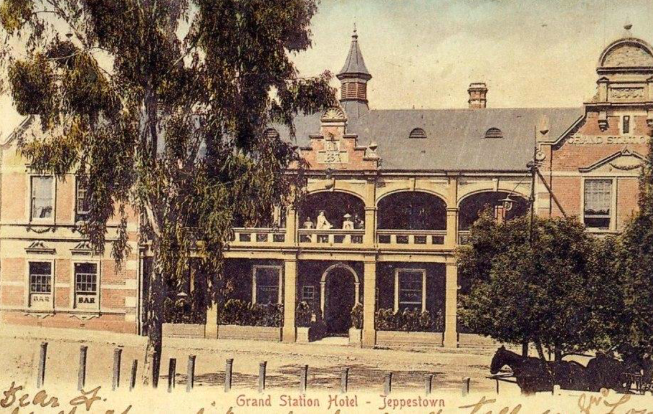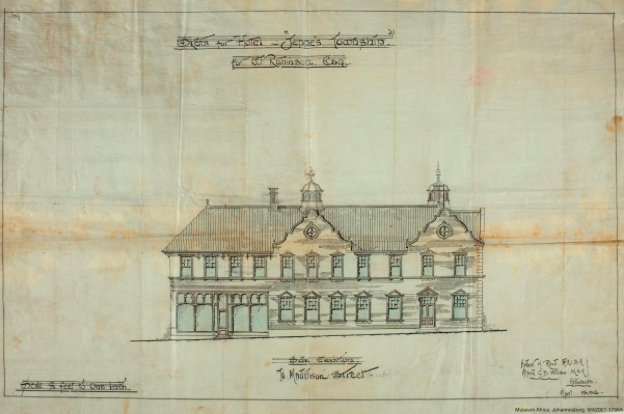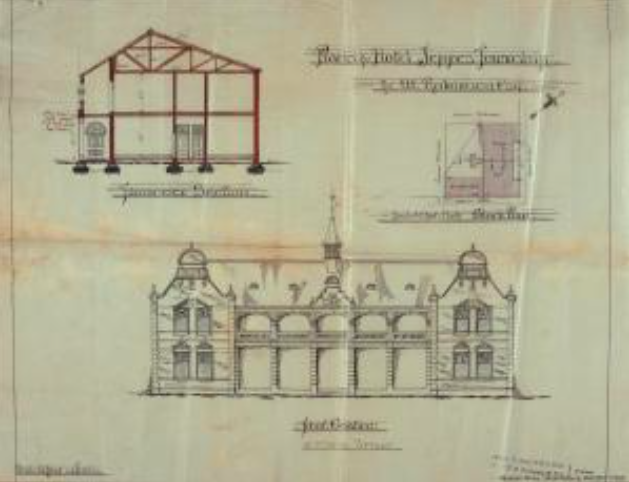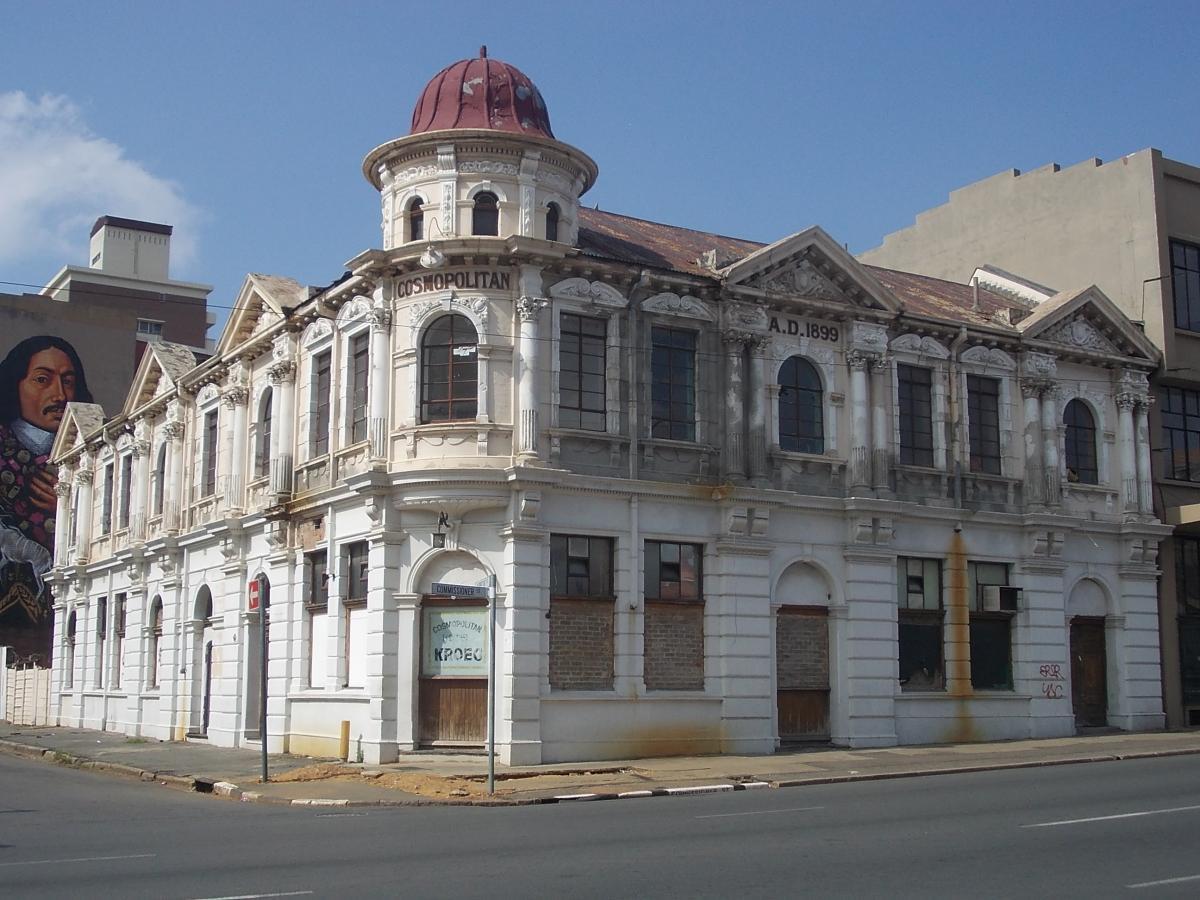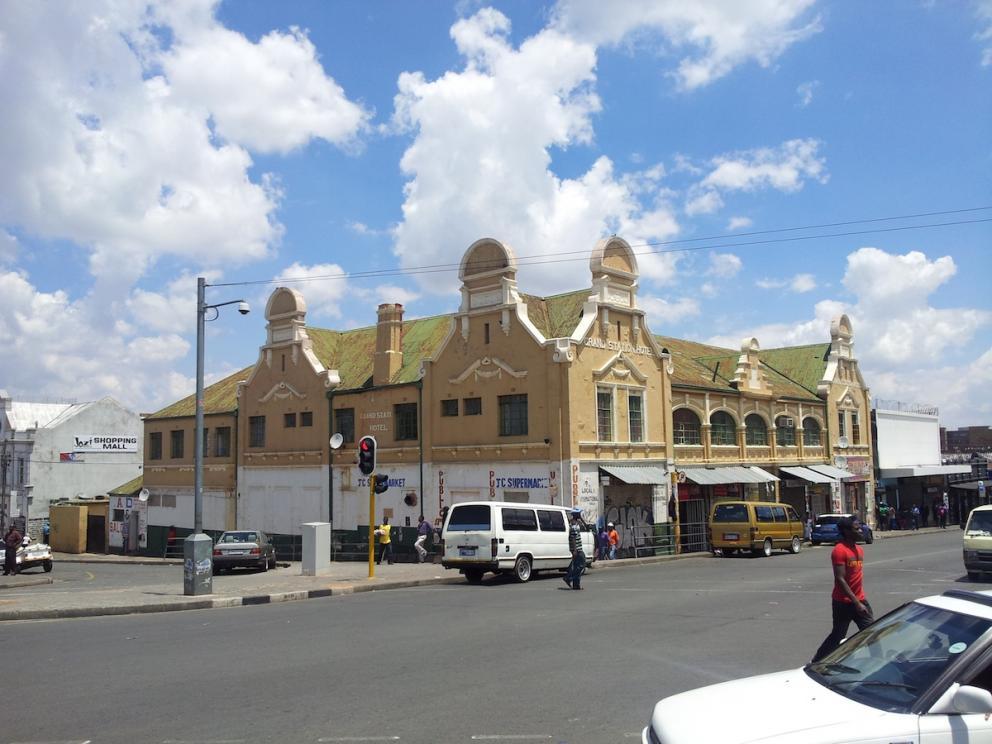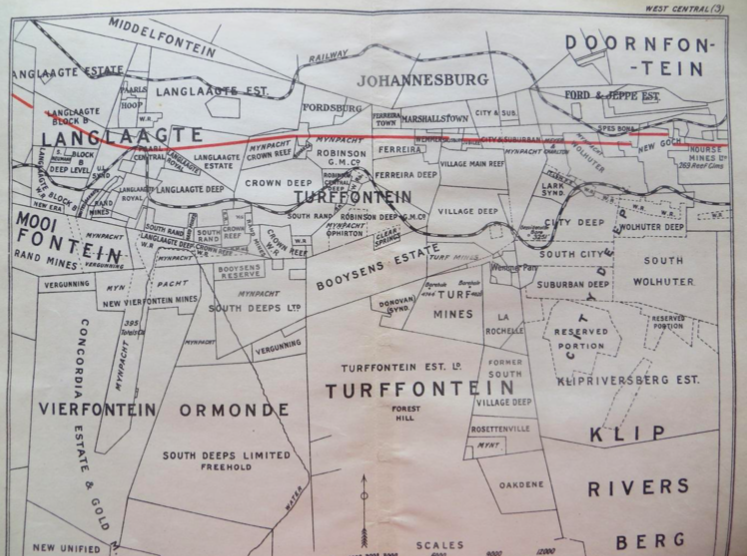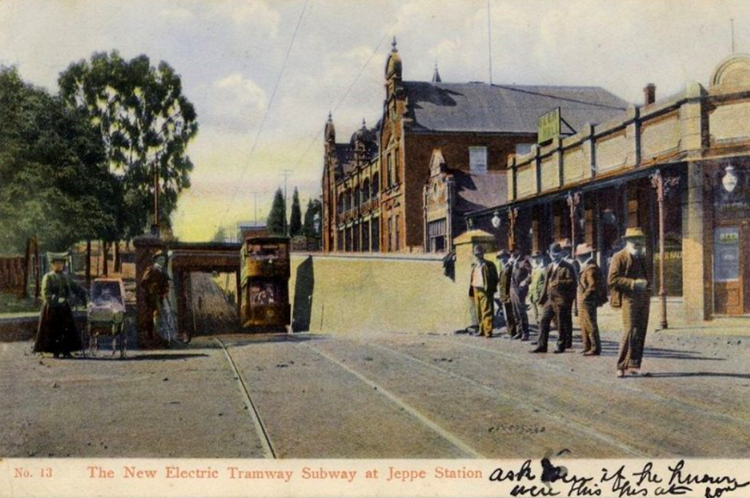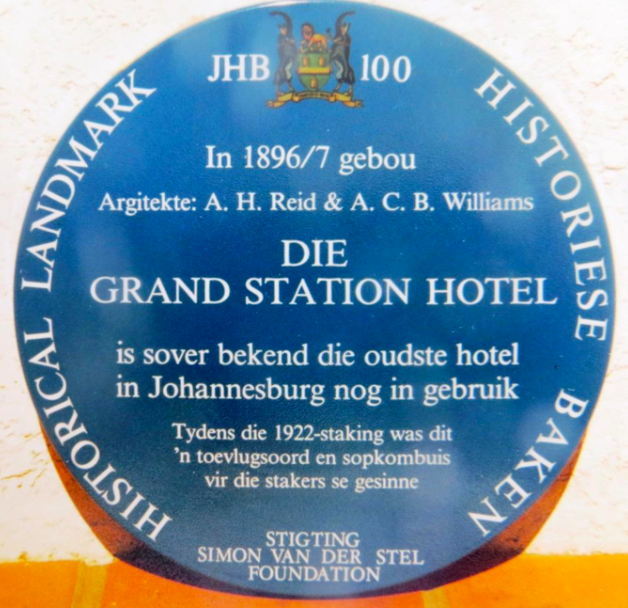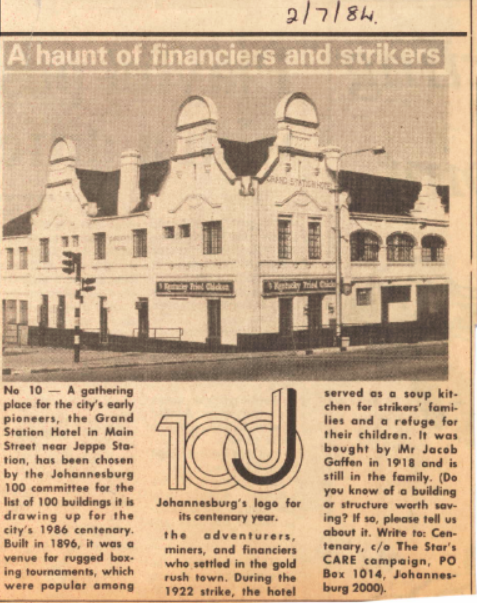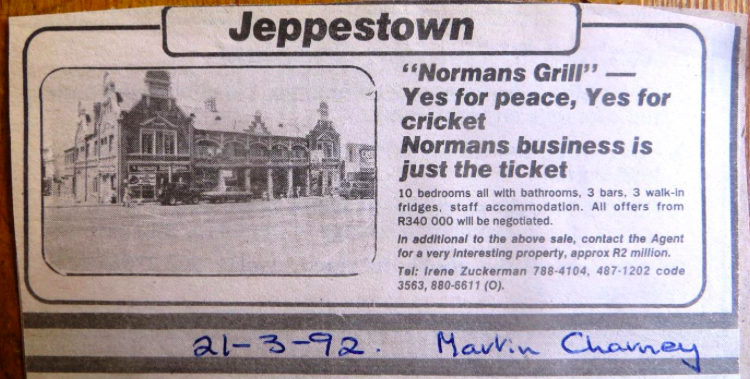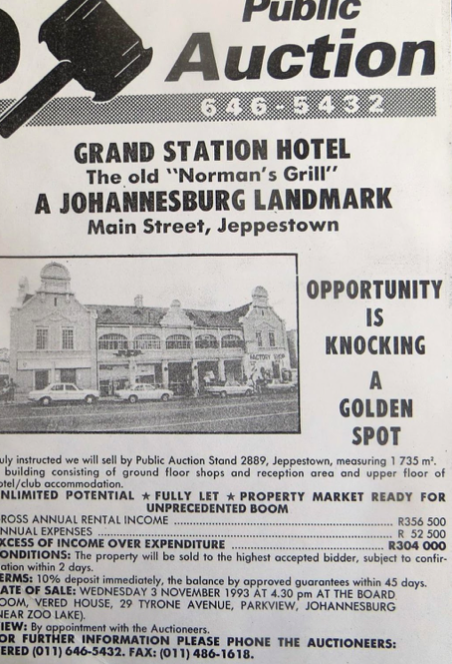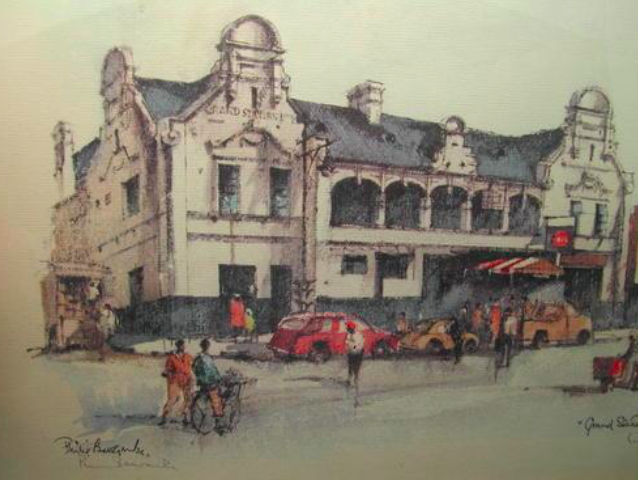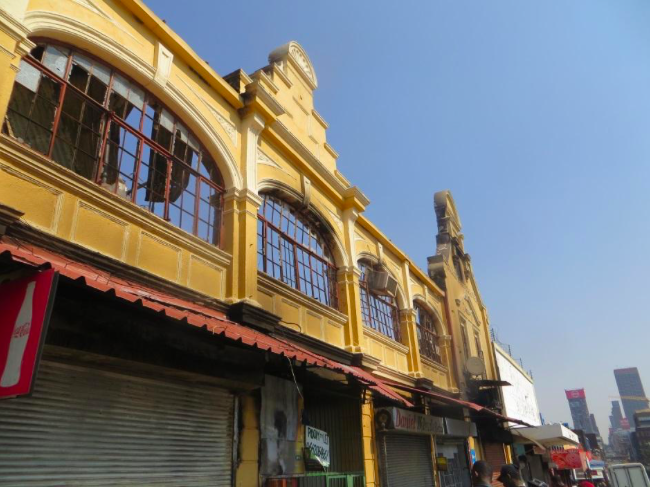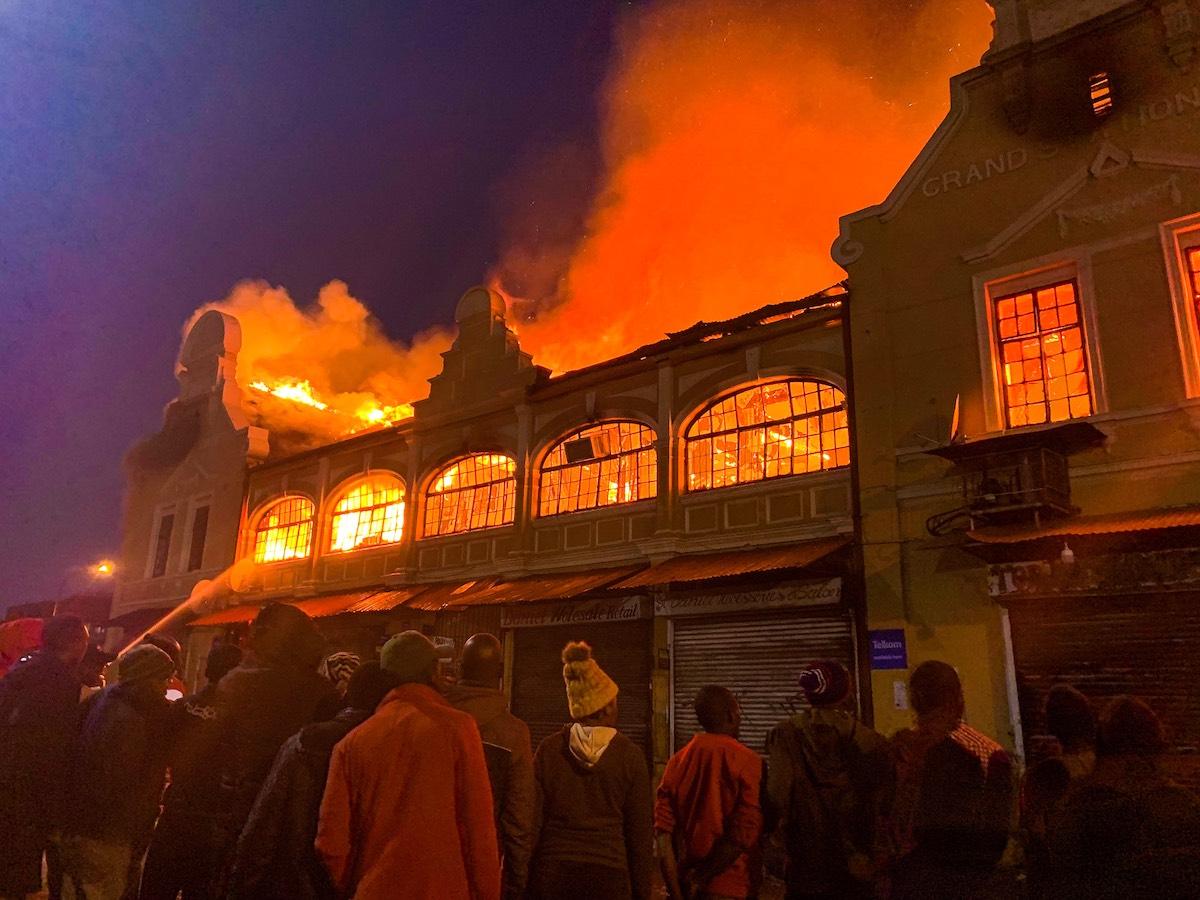
Disclaimer: Any views expressed by individuals and organisations are their own and do not in any way represent the views of The Heritage Portal. If you find any mistakes or historical inaccuracies, please contact the editor.
The Grand Station Hotel went up in flames on Friday evening, 2 August 2019 (main image courtesy of Eugene Ulman). This news reached the Johannesburg Heritage Foundation members at their AGM on the Saturday afternoon. Heritage people gasped with shock, dismay and distress. The hotel was an icon of Johannesburg, it achieved the status of being Johannesburg’s oldest surviving hotel, although by the late 1980s it was no longer run as a hotel.
Aftermath of the fire (Kathy Munro)
It was and still is located in Jeppestown at 302-04 Main Street. The hotel was planned in 1896 and completed in 1897 strategically sited close to the Jeppe Station. Its name said it all, the Grand Station Hotel. It was a hotel that considered itself “grand” and it was close to a station. It was a substantial hotel - the 1896 plan showed 27 bedrooms and a ladies sitting room.
Centenary postcard showing the Grand Station Hotel
The Johannesburg Centenary postcard above shows a view of the Grand Station Hotel in its heyday. It was one of the early hotels of Johannesburg of some substance though not as important as the Grand Central Hotel, the Grand National, the Grand Hotel, Heath’s Hotel or the Northwestern Hotel. All of these hotels featured in Madden Cole’s 1988 booklet Room in the Inn The Story of Johannesburg’s Hotels published by Poplar Press. What is interesting about this small book was that the Grand Station Hotel did not get a mention, and secondly how many Johannesburg hotels in the early years included the word “Grand” in their titles. Johannesburg hoteliers of the early days had pretentions. Hotels were quickly launched following the establishment of the town. These hotels provided a bed, bathrooms (shared), a hot meal and cool beer and spirits. The earliest hotels included Height’s Hotel (1887), the Central Hotel (1887) at the south west corner of Commissioner and Sauer Street, the Grand National Hotel in Rissik Street (between Pritchard and Kerk Streets (1889). There soon were many more hotels; the Grand Station hotel only came a decade later.
Of course the grandest of Johannesburg’s hotels was the first Carlton Hotel which opened in 1906 (see Eric Rosenthal’s Meet Me at the Carlton for a history of that iconic hotel).
Carlton Hotel (Lost Johannesburg)
Hotels mushroomed in early Johannesburg with its male dominated, newly immigrant population. Transitory people in search of gold needed hotels to live in in the fledgling town and Johannesburg of the 1890s, once the shift had been made to deep level mining, was a boom construction town.
According to the Census, in 1896 Johannesburg’s population was 102 000 of which the men numbered just over 79 000. Johannesburg at that date covered an expanse of 3 miles radius from the Post Office. At that date there were 201 hotel keepers and 9 hotel managers; there were 438 barmen and 43 barmaids. Brewing was one of the town’s earliest industries and in 1896 there were 24 brewers, presumably brewing beer. Castle Brewery was an impressive industrial building that dated from 1893 and was located at 148/150 Fox Street, while the well known enterprise of Sammy Marks, Hatherley’s Distillery had their premises in President Street.
Old drawing of Castle Brewery
Returning now to some history and a context. The Grand Station Hotel should also be put into the context of the emergence of a township, when Jeppestown and later Jeppestown Extension which included Belgravia were ambitiously developed as an independent civic unit to the east of the town soon after Johannesburg was proclaimed on Randjeslaagte. These eastern smart townships were conveniently close to Johannesburg falling within a 2 mile radius of the centre of the new town. This township was first created by Jeppe and Company in 1887 on the farm Doornfontein. Land was leased from F J Bezuidenhout and speedily surveyed into building stands. The first auction sale of 400 stands took place in 1888. Mr Julius Jeppe was the founder of Jeppe’s Town. He was the father of Sir Julius Jeppe and became the manager of this new township. In 1889 Jeppestown and Fordsburg were taken over by the Ford and Jeppe Company.
Within a few years this new suburb had transitioned into freehold ownership and by 1894 it was a smart desirable eastern residential town rivalling Doornfontein and Parktown; there were already 421 buildings. Later these were to become suburbs of Johannesburg with subtle social gradations between Jeppe and Belgravia. A township in the early years meant an independent entity with a library and post office.
Incidentally the Post Office building (315 Main Street) is a solid brick built corner building. It has survived but was sold by the Post office in 1989 and given Provincial Heritage status in 1990.
Jeppestown Post Office (Kathy Munro)
The presence of a “square“ or “market square“ made this a prime piece of real estate and hence its expropriation for a railway line and the railway station building. Anna Smith in her account in Johannesburg Street Names hints at a fluidity to the first few years of Jeppestown, as the original Market Square was “cut up by the Railway and partly expropriated by the NZASM railway company”.
We are also able to grasp that Jeppestown in its earliest years was posh confident and upmarket and far more than the chaotic route into today’s city via Commissioner Street. The evidence of older substantial structures such as churches with spires and a fire station in Fairview with an outlook tower reveal that this was an important urban node. These were essential civic institutions of note and authority; the Jeppe family as property men were making money from their sale of stands and talking up the desirability of their part of town but were also ensuring that there were civic amenities and facilities that would draw family men of substance to the suburb. It is an age old lesson well understood by the founders of Johannesburg suburbs - to attract people and to make suburbs work public space, public transport and schools, churches, social clubs, parks and a cricket oval had to be provided . It’s the early sense of workable town planning that makes Jeppestown and Belgravia so fascinating. We are able to read layers of settlement and how demographics of a place were shaped initially. Fortunes could be made not only from the gold mines and the hectic trade in shares on the stock exchange but also in property development. What I find remarkable about Jeppestown is the early sense of civic pride and lay out of the suburb.
Old photo of the Grand Station Hotel (Goch photo album via Brett McDougall)
It is in this context that we should read the Grand in the Grand Station Hotel. In its day, the Hotel was part of the weft and weave of making a Victorian town on the back of gold mining. A transport system was integral to civic success. There were two elements to the transport system by the 1890s: the railway line (first called the Rand Tram) and then the tram routes (initially a horse tramway route up Marshall Street).
Thus the second component of the Grand Station Hotel was the word “Station” in the name. The station referred to the halt or stopping point on first the Rand Tram and then once the railway was here to stay, the railway line that carried on westward to the main Johannesburg station. The hotel was well located, close to the Jeppe Station and its antecedents. Jeppe Halt, originally called Jeppe School, started its life as a train stop within the Netherlands South African Railway Company network and on the route of the Rand Tram (p 96 R C De Jong G-M van der Waal and D H Heydenrych: The Buildings steam Engines and Strutures of the Netherlands South African Railway Company (Pretoria, 1988)). In 1895 the NZASM company erected this small but impressive brick station building replacing an earlier corrugated iron structure. The Jeppe Station was actually planned as a much larger building with two wings but only the central portion comprising the entrance hall, waiting room, luggage room and office was erected pre 1900. The then new station building was contemporaneous with the hotel and was completed in 1896.
Old postcard of Jeppe Station and the Grand Station Hotel
The date of the vintage postcard pictured above is unknown but probably post Anglo Boer War. It is excellent documentary evidence of station and hotel in close proximity and De Jong et al comment that although incomplete at that date, the station was an excellent example of NZASM architecture. Early photographs show the harmonious architectural relationship of hotel and station. Eclectic ZA Wilhelmiens A shared Dutch built Heritage in South Africa by Karel Baker, Nicholas Clarke and Roger Fisher also features a double page chromolithograph picture of the Jeppe Station and tracks in 1902 with the Station Hotel in the background behind a tree (see pages 154-5). In essence the Hotel was there because the Station was there.
If we then read Jeppestown as a transport hub, the hotel filled the obvious need for a railway hotel for passengers disembarking at the station, and perhaps starting their Johannesburg mining sojourn. The main roads ran East along the line of the Main reef (today close to Jules Street and John Page Drive). The Grand Station Hotel was a sentinel gateway to Jeppestown and the grander exclusive Belgravia beyond. The relationship of the hotel to what had been the old Jeppestown Square also made it a more important building.
The question as to why locate a hotel here becomes rhetorical. Every Victorian town with a railway line and a station had a station hotel, whether you were in Melbourne or Johannesburg, Luanda or Roodepoort. The phrase Grand Station Hotel should also perhaps be read in the context of striking a pose as a rival to the Grand National Hotel in Johannesburg; that hotel dated back to 1889 and was located in Rissik Street between Pritchard and Kerk Streets. Anyone of substance arriving in Johannesburg stayed at a Club (with a choice of several such as the Rand, the New or the Athenaeum) or at the Grand National Hotel. Later there were other choices and the Grand Station Hotel was a possibility.
Grand National Hotel circa 1892 (Davies Brothers)
Let's move on to the architecture of the Grand Station Hotel. The architects were the partners Arthur H Reid and Alfred C B Williams, a partnership which ended in the year in which Williams died, 1897. Arthur H Reid is not to be confused with his brother Harry Austin Reid. According to Artefacts, the firm Reid and Williams was responsible for a number of 1890s buildings in Johannesburg. These known buildings as listed on Artefacts were: African City Prop Trust Building c 1896; Barnes Shoe Shop 1897; Grand Station Hotel 1897; Heath's Hotel 1894; Second Johannesburg, Masonic Temple 1896; and Parker Bldg with C Freeman c 1895.
Vintage post card of the Grand Station Hotel via Marc Latilla
For its era it was a “grand hotel” in a modest way for a new thrusting gold mining town. It had distinctive gables on the East and North Facades, moulded decorative plaster work meant to impress, several chimneys, recessed upper varanda balcony running along the front upper floor and a shaded stop at ground floor level. It was a two storey building. The roof was corrugated iron; at that date the iron work would have been imported. The plans (saved in Museum Africa and catalogued by the indefatigable Mary Boyease of the Johannesburg Heritage Foundation) show an upstairs arrangement of 27 bedrooms (none have their own bathroom), a Ladies sitting room, 2 WCs and two bathrooms. The Ground Floor plan shows a dining room, a kitchen, a pantry, a bar and a billiard room all fronted by a verandah. It would have represented an investment of a few thousand pounds. The postcard above shows red face brick and sandstone pilasters. Clive Chipkin commented to me that the significance of the gables was that these were “English style gables” rather than Dutch and the architecture was derived from a different tradition.
Plans of the Grand Station Hotel from Museum Africa. Sourced by Marc Latilla. Records also held at the JHF Resource Centre.
The Grand Station Hotel is best compared to the nearby Cosmopolitan Hotel (dating from 1899) in Commissioner Street, recently restored as an art gallery, where the bar and the vital liquor license are also enduring features. Over the years the hotel gained heritage status and became an admired determined survivor as it was one of Johannesburg’s few remaining pre-Anglo Boer War buildings but van der Waal comments that unlike the Cosmopolitan which remained pretty unaltered, the Grand Station Hotel was extensively changed through the years. The Grand Station Hotel was a far larger hotel than the Cosmopolitan and its facades filling an entire block in Main Street and extending round the corner to Maddison Street made a statement.
Cosmopolitan Hotel (The Heritage Portal)
Grand Station Hotel (The Heritage Portal)
The Grand Station Hotel was a large confident building for its period though within a decade the Carlton Hotel had arrived on the scene bringing London style to the town and in that sense the Grand Station Hotel was modest and slipped into the pre-war (i.e. Anglo-Boer War) era, and could be stamped late Victorian.
The central feature of such hotels was surely the bar which drew the thirsty miners from the nearby Wolhuter mine, which lay to the south of Jules Street. But with its Ladies Lounge this was not just a miners’ pub. Respectable ladies could feel comfortable as guests. Early Johannesburg hotels served several purposes. They were places of entertainment, comradeship and hospitality. Hotel connected barmaids and bar loungers sprawled on solid bar counters. The liquor licence turned a hotel into a private pot of gold. The familiar hotel and bar games were billiards, darts, dominoes and boxing. Marc Latilla relates that Joseph Rabinson (sic) the original proprietor of the Grand Station Hotel who also owned the Fountains Hotel in Fordsburg was a boxing promoter who held boxing matches at his hotels. According to Norwich the big name boxers of the day were Jack Lawlor, Johnny Squires and Tommy Bensch. Rabinson it seems survived until 1919 (note Norwich has his initial wrong as an L Rabinson) and the hotel then passed to Jacob Gaffen.
The undeniable proximity of the Ford and Jeppe Estate to mines such as Wolhuter, New Gogh, Spes Bona, Meyer and Charlton was a negative long term indicator for grand property development. The flowering of Jeppestown and Belgravia was relatively short and by the 1920s and 30s and perhaps even earlier, wealthy residents were migrating and relocating northwards. There was a solid core of artisan mining occupation residents and home owners but those further up the social and economic scale preferred to live further away from the actual mines which underpinned their wealth. My reading of the rise and decline of Jeppestown was that the mines made the Ford and Jeppe estate but ultimately the money did not stick to the area and there was a long slow decline in these older eastern suburbs, leaving behind grand dreams and fingerprints of former affluence in the now heritage demarcated buildings.
This map is from The Statist’s Mines of the Transvaal by R R Mabson, 5th Edition 1908-9, published in London. It gives us clues to the rise and fall of old Johannesburg.
It is also worth noting that the blue plaque installed in 1986 records that during the 1922 Strike the hotel was a soup kitchen for striking miners. I have no documentary evidence of this piece of lore but it is believable that it would have fitted the character of a youthful Norman Gaffen with a mix of socialist and later Zionist sympathies but also with a work ethic to succeed as an immigrant hotel keeper.
Tram subway on Main Street passing in front of the Grand Station Hotel. No date post 1906 (A Johannesburg Album)
This early postcard is an interesting one. Sourced originally from the Transnet Museum (S A R Publicity and Travel Department) and also reproduced in the Johannesburg Album of Norwich, it introduces another strand of transport history into the story of the Grand National Hotel. This is a tram subway dating from the Ewardian era. A new electric tram system was introduced in 1906 replacing the horse trams; the route changed from Marshall Street to Main Street and the subway was built which took the trams below street level through a viaduct. The subway system was abolished in the 1930s and that was the decade when the old Jeppe station was demolished and the current station was built. The visual documentary evidence is invaluable as it shows the tramway in relation to the hotel.
Despite changes and compromised integrity during upgrades in the 1960s, enough of the original shape, fitting and design remained for it to be a prized early Johannesburg building.
The Star photograph of the Grand Station Hotel with Norman’s Grill circa 1981 (JHF Records)
In 1986 the Johannesburg 100 Committee identified the Grand Station Hotel as a heritage site worth celebrating and awarded it a Jhb 100 Simon Van der Stel plaque. (JHF Records)
The hotel was number 82 on the list of one hundred places of Outstanding Cultural, Historical, Architectural and Natural interest, a list published by The Star and compiled by the Johannesburg 100 committee. The hotel survived but more as bar and restaurant not as a residential hotel. (The Star)
By 1989 the National Monuments Council was approached by “certain property developers” who at that date proposed to upgrade the old hotel building to include offices, shops, restaurant and a bottle store. At that date Flo Bird resisted demolition and took the view that whilst the interior could be altered, the façade was significant. This information is derived from a JHF file note but there is no further follow up as to whether changes went ahead. By the end of that year PEP stores was being considered as a possible tenant and by 1990 interior alterations were proposed and approved with certain stipulations laid down by the NMC. However, as there was no further correspondence on record it would appear that the proposal was dropped.
In 1992 the Grand Station Hotel with its jewel Norman’s Grill was on the market for the modest price of R340 000 upwards. At that date it had 10 bedrooms all with bathrooms, 3 bars, 3 walk in fridges and staff accommodation. Still attractive but no longer a prime hotel. (JHF records)
An October 1993 property advert. The building was on sale again but this time by public auction with Vered. The advert calls it the Grand Station Hotel so the assumption is that in 1992 the property did not sell. In 1993 the potential is being talked up to reinstate the “hotel/club accommodation”. If all property adverts delivered this would have been an excellent purchase for the anticipated boom times ahead and if the year before the property on sale invited offers from “R340 000“ and a return from gross rental would yield a net figure of R304 000 for a piece of prime Johannesburg real estate, it was a bargain we all missed. (JHF records)
Everyone wants to know who was Norman. He was Norman Gaffen who was the son of Jacob Gaffen. Jacob was the second proprietor of the Grand Station Hotel. His family’s roots were in Kovna, Lithuania where Jacob was born. He came to South Africa at the age of 14 to avoid being drafted into the Russian army. Jacob came alone and worked in a general store on the mines in Johannesburg. He gradually built himself up until he owned a hotel in Johannesburg, namely the Grand Station Hotel. His daughter Rita recalls that he invested in other hotels in the country districts, and 2 others in Jo'burg. He went down to Cape Town, was introduced to Rei. They were married in 1917 in Cape Town and moved together to Johannesburg. Oscar Norwich in his Johannesburg Album records that Jacob Gaffen acquired the Grand Station Hotel in 1919. He was the owner until his sudden death in 1938.
The Gaffens had three children: Norman (b 1918), Rita (b 1922) and Joy (b 1926). Rita recalls that: “About a year before Jacob died Norman took over the running of the hotel as a young boy of 17, with the help of Rei, his mother. He sorted the administration of the business and she helped with the books. They continued working together until they both passed away in 1986 (4 months apart). Rei died on the 15th of August, Norman on the 20th of December.” That was the end of an era.
I remember The Grand Station Hotel as the place for a fabulous prawn meal in the seventies and eighties at Norman’s Grill. As young newly weds, my husband and I went almost weekly to the Grand Station Hotel. This restaurant's speciality was Lourenço Marques prawns and everyone came to Jeppestown for the feast of a prawn platter.
In 1974 Frelimo occupied Lourenço Marques and the prawn fishing fleet that trawled for prawns was sold on the dockside in the midst of revolution by the previous Portuguese owner. It went for a paltry sum as he caught the last plane back to Lisbon. The purchaser was a young white Mozambiquean by the name of Da Fonseca who had decided to stay whilst his whole family had emigrated. The new owner of the LM prawn industry was allowed to run a capitalist operation in the midst of a hard line communist regime by supplying the new political elite with fresh fish and exporting his prawns to Johannesburg. At least this is the story my husband tells me. He had met the gentleman so information was first hand but it’s still oral history. The secret of Norman’s success was serving these large LM prawns, cooked to perfection and providing a quality meal at a modest price.
Another early record we have of The Grand Station Hotel are the watercolours of Philip Bawcombe
In 2014 the Grand Station Hotel was placed on action and received a top bid of R3 million. The vendor roll (2014) describes the hotel as follows: “Today the building with a gross building area of 1,075m² on a 1,487m² erf is fully let, including five shops on the ground floor, 38 residential rooms, 13 of which have en suite facilities. The building has a gross annual income of R1.2m a year.”
The Hotel was protected in terms of the National Heritage Resources Act but a fire does not respect heritage or legislation and is our greatest enemy. Rumour has it that the fire raged out of control because Johannesburg has a tiny number of operating fire engines. This surely can’t be true. It is ironic that a landmark hotel, over 120 years old, located within half a km of the Fairview Fire Station should fall victim to fire. In 2018 The Grand Station Hotel fell prey to potential hijackers and the City ‘s JMPD and Mayor Mashaba stepped in to stop to arrest the alleged hijackers.
Daylight on Saturday showed the burnt out shell of a much loved and prized heritage treasure of Johannesburg. Alas the Grand Station Hotel is no more. The immediate question is will it rise from the ashes? The gables are still there and my view is that if there is capital, willpower, city capacity and a strong heritage lobby this is a property that can be saved.
What remains of the Grand Station Hotel (Kathy Munro)
Kathy Munro is an Honorary Associate Professor in the School of Architecture and Planning at the University of the Witwatersrand. She enjoyed a long career as an academic and in management at Wits University. She trained as an economic historian. She is an enthusiastic book person and has built her own somewhat eclectic book collection over 40 years. Her interests cover Africana, Johannesburg history, history, art history, travel, business and banking histories. She researches and writes on historical architecture and heritage matters. She is a member of the Board of the Johannesburg Heritage Foundation and is a docent at the Wits Arts Museum. She is currently working on a couple of projects on Johannesburg architects and is researching South African architects, war cemeteries and memorials. Kathy is a member of the online book community the Library thing and recommends this cataloging website and worldwide network as a book lover's haven.
Sources
- Johannesburg Heritage Foundation Resource Centre – archive. Grateful thanks to Mary Boyease, Flo Bird and Diana Steele.
- James Ball, The Heritage Portal and Heritage Register
- Philip Bawcombe (1973), Bawcombe’s Johannesburg
- Rita Myerson, The Gaffen Family http://rmyerson.blogspot.com/,
- Mabson, R R (1908), The Statist’s Mines of the Transvaal , 5th Edition, 1908-9, London
- Oscar Norwich: A Johannesburg Album
- Tony Spit: (1975), Johannesburg’s Tramways (with Brian Patton)
- Madden Cole (1988), Room in the Inn The Story of Johannesburg’s Hotels published by Poplar Press.
- Anna Smith (1971), Johannesburg Street Names, Juta and Co
- G M Van der Waal (1987), From Mining Camp to Metropolis: The Buildings of Johannesburg, 1886-1940 (Pretoria: C. van Rensburg Publications for the Human Sciences Research Council)
- De Jong, R.C Van Der Waal, G.M & Heydenrych D.H (1988), NZASM 100-1887-1899. The Buildings, Steam Engines and Structures of the Netherlands South African Railway Company (Chris Van Rensburg Publications, Melville, 1988)
- Bakker, K.A., Clarke, N.J. and Fisher, R.C. (eds.) (2014) , Eclectic ZA Wilhelmiens: A shared Dutch built heritage in South Africa, Pretoria: Visual Books
- Marc Latilla’s website Johannesburg 1912
- Thanks to Eugene Ulman who captured the fire,
- Grateful thanks to Clive Chipkin, James Ball, Herbert Prins, Paul Kotze, Flo Bird, Mary Boyease, Brett MacDougall, Diana Steele, Marc Latilla, Mark Straw, Eugene Ulman, Isabelle Pingle and Keith Munro who share my passion for heritage research, architectural history, heritage survivals, Joburg jaunts or my passion for prawn meals. I also thank the taxi drivers of Johannesburg who I have found to be unfailingly courteous in showing me into their parking bays and giving a friendly wave.
Comments will load below. If for any reason none appear click here for some troubleshooting tips. If you would like to post a comment and need instructions click here.

